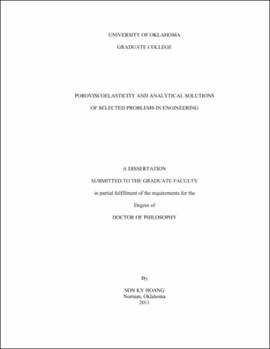| dc.contributor.advisor | Abousleiman, Younane N | |
| dc.creator | Hoang, Son Ky | |
| dc.date.accessioned | 2019-04-27T21:27:06Z | |
| dc.date.available | 2019-04-27T21:27:06Z | |
| dc.date.issued | 2011 | |
| dc.identifier | 99203720602042 | |
| dc.identifier.uri | https://hdl.handle.net/11244/318713 | |
| dc.description.abstract | This study provides newly-derived analytical poroviscoelastic solutions for a number of practical and important engineering problems with various levels of material anisotropy: laboratory and field testing of cylinders (isotropy, transverse isotropy, and weak orthotropy), laboratory testing of rectangular strips (isotropy, transverse isotropy, and orthotropy), and wellbore drilling and tunnel excavation (isotropy and transverse isotropy). The solutions for these problems are crucial in many disciplines such as civil engineering, petroleum engineering, and biomechanics. The newly-derived solutions can be considered extensions of some existing analytical solutions to a higher degree of anisotropy. However, the importance of material anisotropy is self-evident in engineering applications since many bio- and geo-materials are intrinsically anisotropic and their mechanical anisotropy can significantly influence the material behavior as illustrated throughout this dissertation. The frequently-used assumption of material isotropy in poroviscoelasticity to simplify modeling and analysis is therefore no longer justified without thorough calibration and validation. | |
| dc.description.abstract | More important, this study finally establishes the correspondence principle between poroviscoelasticity and poroelasticity with general anisotropy based on rigorous mathematical and physical considerations. The correspondence principle has been established not only in time domain but also in Laplace transform domain, for the general phenomenological formulation as well as for the micromechanical relations between material coefficients, and will be of fundamental importance in the study of poroviscoelasticity. In particular, using the correspondence principle, analytical poroelastic solutions in the Laplace transform domain with any degree of anisotropy can now be readily transferred to poroviscoelasticity and vice versa. | |
| dc.format.extent | 142 pages | |
| dc.format.medium | application.pdf | |
| dc.language | en_US | |
| dc.relation.requires | Adobe Acrobat Reader | |
| dc.subject | Fluid dynamics | |
| dc.subject | Porosity | |
| dc.subject | Viscosity | |
| dc.subject | Elasticity | |
| dc.subject | Anisotropy | |
| dc.title | POROVISCOELASTICITY AND ANALYTICAL SOLUTIONS OF SELECTED PROBLEMS IN ENGINEERING | |
| dc.type | text | |
| dc.type | document | |
| dc.thesis.degree | Ph.D. | |
| ou.group | College of Engineering::School of Civil Engineering and Environmental Science | |
